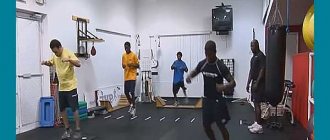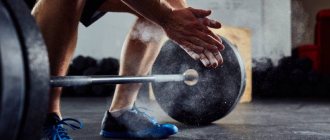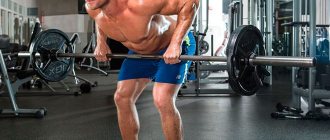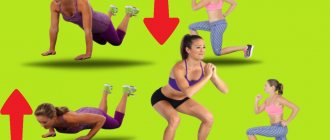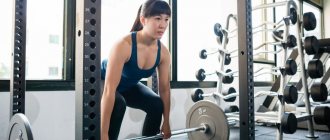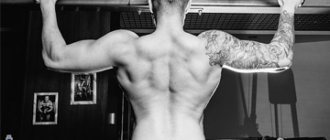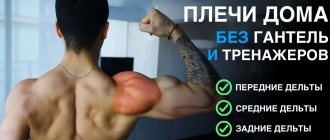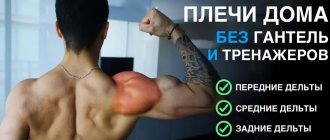There are plenty of reasons for men and women to exercise their chests.
Most people's primary goal is to improve its appearance. Thanks to the variety of exercises with your own weight, everyone can achieve this in a comfortable environment - at home. Such training is good for both beginners and people with sufficient training. Developed breasts are:
- Beautiful appearance
- Force
- Plus for posture
- Good respiratory function
Bodyweight offers enough exercise for any fitness level. With their help, you can even locally strengthen each area of the chest: upper, middle, lower
.
About the importance of pumping the pectoral muscles
The pectoral muscles include two main muscle groups.
These are the pectoralis major and minor muscles. The latter are located under the larger ones and, as can be understood from their name, are smaller in size. Since the fibers of the chest muscles extend in different directions, several muscle regions are distinguished among them - internal, external, upper and lower. Inflated pectoral muscles generally develop the chest adjacent to the lungs. By pumping your chest muscles, you will not only make them stronger and more impressive in appearance, but also create additional space for your lungs and improve the breathing process. Evidence of this are outstanding bodybuilders with powerful chests, demonstrating the strength of the chest in the aggregate and deep breathing.
Doing strength exercises with your own weight
, it should be borne in mind that different parts of the chest will be simultaneously involved and, depending on the specific exercise to strengthen the muscles, the load on them will be distributed differently.
Features of chest training
From the point of view of human anatomy, the main muscles of the chest are the pectoralis major and minor muscles. The first one looks like a triangle. One of its bases is woven directly into the shoulder, so the pectoral and shoulder muscle tissues are interconnected. Under the large muscle is the small one. It performs more of a stabilizing function than a working one.
The pectoral muscle complex includes the serratus anterior muscle, which lies closer to the lateral region of the torso, as well as the shoulder. This structure is attached to the ribs using serrations. Its main function is to abduct and approximate the shoulder blades. It is the serratus muscle that provides abduction and abduction of the arms. Performing exercises on adduction and extension also helps to pump it up.
Important rules for developing and increasing muscle tissue of the sternum:
- Muscle mass will begin to grow only under the condition of a stable increase in loads. Therefore, over time, it is important not only to add weight to dumbbells, kettlebells or barbells, but also to multiply the number of approaches. Muscle structures will respond to regularly exposed stress with rapid growth. In order for muscles to develop, it is important to monitor not only training, but also provide the right diet that helps increase muscle mass.
- In order for the figure to develop correctly and be proportional, one more condition must be met - to pump different areas of the pectoral muscles evenly.
- Muscles need to be kept at rest. Exhausting exercises performed every day without a single pass will not bring the expected results if you do not give your muscles a rest. The fact is that muscle mass grows precisely during rest, but if it is absent, then the muscles will simply have no time to grow. In this case, the ideal option would be to organize training twice a week, with a maximum of 8 to 10 approaches.
How to properly pump up your chest muscles with your own weight
You can achieve high-quality mass gain for the pectoral muscles by performing only exercises for training with your own weight, with almost the same efficiency as when using sports equipment. Not always and not everyone has the opportunity to go to the gym, and not everyone is ideally suited to visit it, and you may simply not have dumbbells at home, not to mention a barbell. You can, of course, think about buying a membership to the nearest gym or saving up money for a couple of weighty dumbbells, however, if you want to pump up your chest well, you don’t have to worry about all this. Bodyweight exercises for gaining mass will perfectly cope with the task of pumping up the pectoral muscles with a diligent, systematic and correct approach.
In order for home training to pump up your chest to the maximum and bring highly effective results, it is important to follow a few simple rules. First, be sure to warm up before doing chest exercises.
. Warming up allows you to disperse blood throughout the body, warm up muscles and activate joints, which makes further exercise more effective and safe. Secondly, when exercising outdoors, both in warm and cold seasons, do not forget to dress appropriately. Clothing should be comfortable, not cause overheating and reliably protect from cold winds and low temperatures. And finally, thirdly, be sure to follow the instructions for performing the exercises. The bodyweight strength training program selected on our website Kak-Nakachat.Pro is based both on the personal experience of its creators and on a systematic approach to the recommendations of a wide range of experienced bodybuilders. Maintaining the correct technique in exercises will be the key to getting quick and noticeable results from your training.
Mistakes when performing chest exercises
This type of exercise is very often performed by athletes; performing it correctly allows you to quickly achieve the desired result. However, among gym goers you can often find the following common mistakes:
- Weight abuse. It is known that the use of heavy weights has a beneficial effect on the development of chest muscles. However, you need to remember that when working with significant weights, a considerable share of the load goes to the triceps and deltoids. Therefore, in order to achieve the maximum effect specifically for the chest area, it is recommended to slightly reduce the weight, but pay more attention to the technique of performing the exercise.
- Chop. It makes lifting weights easier and allows you to do more repetitions. But the impulsiveness leads to less stress on the chest, and increases the likelihood of injury.
- Split exercises with back or legs. If you need to acquire basic indicators, the press-dead-squat triple will be quite justified. This complex is also suitable for powerlifters. But if the athlete’s task is to work out the chest, it is better to refuse it. The accumulation of fatigue during deadlifts and squats will not allow you to fully load the pectoral muscles and get the desired result. If you want to combine exercises, then working out the triceps or biceps is better suited for this.
- Limit to bench press. This exercise can serve as a basic exercise for the pectoral muscles. But efficiency can be increased by adding wiring. You should also practice incline presses.
- Neglect of exercise equipment. Many athletes rarely resort to using exercise machines, considering them insufficiently effective due to their fixed amplitude. However, this opinion is wrong. Exercise machines allow you to concentrate on a specific muscle group and work out lagging muscle groups. They will be most effective when used correctly after the main press, but before flyes.
A set of push-ups for breast pumping
To pump up the pectoral muscles using your own weight, all types of push-ups are suitable: both from the floor and on the uneven bars. Let us highlight some of them that, in our opinion, are most relevant to the task at hand:
• Push-ups with wide arms; • With a narrow position of the hands; • With feet on a hill; • With cotton; • With hands at the waist; • On parallel bars with knees to chest.
When doing push-ups, it is very important to maintain proper body position. It must be kept level, and the pelvis must not be allowed to lower or protrude. Try to perform movements smoothly and slowly. Also monitor the tension of the target muscles during exercises - it should not fall.
Wide hand position
during push-ups, it most activates the middle and outer region of the chest muscles. To perform the exercise, follow this technique:
1. We take a lying position, placing our hands shoulder-width apart. At the same time, do not forget to monitor the position of the torso and legs - they should be on the same straight line. 2. Inhaling, lower the body to the floor. How deep the push-up is is a good way to regulate the level of load and muscle involvement. Deeper push-ups promote increased activation of the mid-chest area. At the same time, the load on the shoulders also increases, which should be taken into account when doing deep push-ups. 3. When exiting, we return to the starting position.
In one approach at the initial stage of training, it would be optimal to perform 15 push-ups. We do at least 2-3 approaches, depending on the physical condition and the overall load of the training program.
Narrow hand position
in push-ups, the emphasis is on working the inner chest area. To begin the exercise, take a lying position with your arms narrower than shoulder width.
An option for push-ups is also to perform the exercise with your feet on a hill
.
Due to the fact that the legs are located higher than the rest of the body, the load falls on the upper chest area, which is the most important area to pay attention to when starting to do bodyweight chest exercises
. This is due to the fact that, as a rule, this part of the chest is the least developed in beginning athletes.
One of the advanced variations of push-ups is to perform this exercise with a clap.
. In this case, the practitioner receives excellent stimulation of the chest muscles for their active growth.
Push-ups with hands at the waist
- another type of exercise that can be classified as leading. In fact, such push-ups are a more simplified version of the exercise called “horizon” or “planche”. Different muscles are involved - round on the back, anterior deltoids and pectoral muscles.
When performing push-ups on parallel bars
It is important to choose their width. When working the pectoral muscles, wide bars are best suited, since the load will fall on the lower chest area. Unlike push-ups on the floor, which can always be done as home exercises, here you will most likely need to go to the nearest sports ground or stadium. If you have a choice of beams, use the most optimal height option.
Dips
Another great exercise to pump up your pectoral muscles. It requires timber, which fortunately can be found in almost every yard.
All variations of parallel bars exercises, to a lesser or greater extent, develop the chest. In order to shift the load on the pectoral muscles, try doing them in a tilted position - slightly falling your body forward and slightly raising your legs.
Bent-over parallel bars
The upper body is leaned forward, the legs are raised and maintain balance.
In this position, the area we need is more actively involved.
If the exercise is performed in the usual form: the torso is in an upright position, then the load falls more on the triceps.
What exercises to do for the chest muscles
There are many other types of push-ups that are suitable for chest training. Among them are such exercises as: push-ups with a raised pelvis, tilted up or down, from a bench, on chairs with a wide grip, resting on one leg or on all fours, push-ups in an uneven mode, diamond push-ups, isometric, in the folding positions knife", "corkscrew" or "archer", snake press, Indian press, Maltese press, push-ups on gymnastic rings, etc. It is not necessary to use many different push-up variations in your workout program. It is more important to choose exercises to strengthen the chest that activate the entire muscle group. The set of push-ups we have presented helps to include different areas of the chest muscles in the load, which will be quite enough for their full training.
Bodyweight training
The results are promising with active exercises with a certain frequency. The proposed training program for the chest muscles must be performed at least once a week. The load should be as maximum as possible. If you want to train your chest muscles more often, for example, twice a week, then repeat training should be done in a lighter mode - reduce the load, reduce the number of approaches.
On our website How-to-Pump Up.Pro you will find comprehensive information about training with your own weight for men and women for various muscle groups. We present both descriptions of various exercises and educational information about the correct approach to exercise to achieve serious and impressive results. See our catalog and other sections of the site for all the necessary information.
A set of exercises for the pectoral muscles
If you are a beginner, start with the exercises of this complex. By working with your own body weight, you will strengthen your chest muscles and master basic exercises for this area. And over time, the load can be increased and you can switch to exercises with additional weights.
How to build a lesson
- Start your workout with a short warm-up.
- Perform the exercises sequentially in 2-3 sets of 8-16 repetitions each (unless otherwise indicated in the description).
- Finish your workout with stretching.
- Do this program 2-3 times a week.
To perform the complex you will need a horizontal bar, a bench and an expander with handles.
Pull-ups with expander
1-pull-ups
Attach a long expander to the horizontal bar so that one of its edges hangs as close to the floor as possible. Place your feet in the loop of the expander, grab the horizontal bar with your hands with a straight, wide grip. Bend your elbows, working the muscles of your arms and chest, pull your body up. Do not arch your neck and lower back, activate your abdominal and back muscles. Then smoothly straighten your elbows and lower yourself to the starting position. This is one repetition, do 8-10 of these . If this is not yet possible, do as many repetitions as you can handle. Rest for a minute, perform 2-3 sets.
Pull-ups
2-pull-ups
Stand facing a low horizontal bar or bar. Place your palms on it, shoulder-width apart. Place your feet hip-width apart so that your body is one straight line. Actively work the muscles of your abs, back, chest and arms. Bend your elbows and point them to the sides, lower your body down, bringing it closer to the bar. Then straighten your elbows, returning to the starting position. This is one repetition, do 8-12 of these . Rest for a minute, perform 2-3 sets.
Reducing hands with an expander
3-bringing hands together with an expander
Stretch the expander around a vertical support, stand with your back to it and grab the handles of the expander. Place your feet shoulder-width apart, raise your arms with the handles to shoulder level and spread them to the sides. This is the starting position. Then, working the muscles of your arms and chest, bring your palms together at chest level, stretching the expander. This is one repetition. Do 8-16 of these . Rest for a minute, perform 2-3 sets.
Push-ups with steps
4-push-ups with steps
Lower yourself to the floor, resting on your knees. Take a lying position, leaning on the toes of your feet and palms. Place your palms shoulder-width apart. Work your abdominal muscles, back, chest and arms. Don't bend at the waist, don't slouch. Shift your body weight to the right half of your body and “step back” with your left hand to the left. Bend your elbows and lower your body down. Then return to a vertical position, shift your body weight to the left half of your body and “step back” with your right hand to the right. Bend your elbows and perform a push-up. This is one repetition. Do 8-16 of these . Rest for a minute, perform 2-3 approaches.
Push-ups with body rotation
5-push-ups with a turn
Place your palms on the bench, put your feet back and rest on your toes so that your body forms one straight line. Stretch your head forward and your feet back. Don't slouch, work your abdominal muscles, arms and chest. Bend your elbows and point them to the sides, perform a push-up, lower your body down. Straightening your elbows, return to the starting position. From there, transfer your body weight to your right palm, pull your left up, turning your body to the left. Return to the starting position and perform a push-up. Then straighten your elbows, transfer your body weight to your left palm and turn your body to the right, extending your right arm up. This is one repetition. Do 8-16 of these . Rest for a minute, perform 2-3 approaches.
Exercise according to this scheme 2 times a week. Don’t forget to train other muscle groups - this is important for the harmonious development of your figure.
Back
Like the chest, the back can be trained quite easily using your own weight. It depends on how strong you are at pull-ups.
There are a huge number of pull-up options: wide, medium, narrow, straight, reverse grip, etc.
If you can't do more than 8 reps on your own, use a resistance band attached to your legs or ask a partner for help. Another important exercise for developing your back is horizontal pull-ups. It is most convenient to do it in a Smith machine or in a power rack. Place the bar at a height slightly greater than arm length and pull yourself towards it.
Shoulders
You can perform a kind of shoulder press exercise using only your own weight - handstand push-ups against a wall. Go down and go up. The head will limit the range of movement. If you're not fit enough to do 10 upside down pushups, replace them with L pushups. Your head will be down, but your toes will be on the bench or cabinet so your feet will be roughly parallel to the floor. The body will be bent like the letter L. There are also push-ups with the pelvis pulled back. Each rep starts and ends like a regular push-up, but at the top, you push your pelvis back by straightening your arms and bending your knees. This exercise has a longer time under tension than the L push-up or wall rack push-up.
All of these exercises load the front deltoids.
To a lesser extent, this is done by classic push-ups from the floor or on uneven bars. The rear delts work during pull-ups and horizontal pull-ups.
